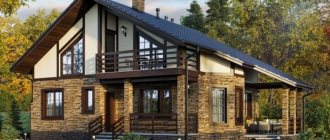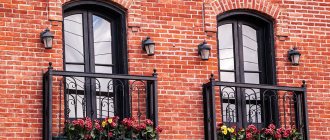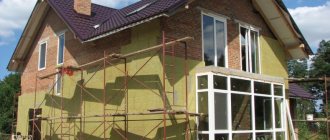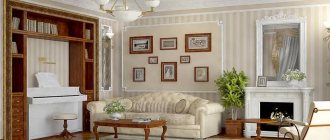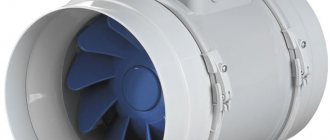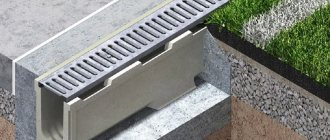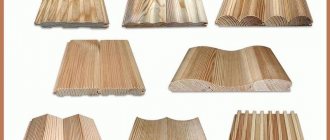Decorative ventilation grilles are designed to frame channels that provide air exhaust or supply to the room. The elements are made of plastic, metal with a decorative paint coating or other materials. It is possible to install a check valve that does not allow air flow contaminated with foreign impurities to enter the room.
Installation of ventilation grilles
The ventilation grille, despite its simplicity, is a reliable design solution. The rigidity of the product is ensured by a durable frame. It can be combined with the air duct or fixed to the wall surface. In larger lattices, the structure is divided into several smaller sectors, and this is done using a frame. Due to this, the strength characteristics of the product are increased. A removable plastic or metal panel covers the working area of the grille. It should be noted that distributors are:
- adjustable - the direction of air masses can be changed;
- non-directional action – oxygen easily penetrates into the room, often playing a decorative role.
- with shut-off valves. Grilles of this type are installed at enterprises, warehouses and industrial complexes. They eliminate the effect of reverse draft and prevent the penetration of dust and small insects. This design ensures that contaminated air moves exclusively outward. It can also be installed in an apartment to prevent unpleasant odors from coming from neighbors.
- Inertial blinds their operation is similar to solutions with a check valve. Horizontal slats move and block the air flow. To ensure quick adjustment, light and reliable materials (PVC, aluminum) are used.
Ventilation grilles are often equipped with horizontally located blades, thanks to which you can regulate the intensity and direction of the supplied air.
The cleaning process boils down to removing the decorative overlay. After which the product can be treated with detergent and washed under running water.
Removing the decorative part for cleaning
Purpose and role
In fact, the ventilation system is one of the most important engineering structures of any house, regardless of whether it is private or multi-apartment. It is ventilation that is responsible for proper air exchange, as well as for comfortable climatic conditions in each individual apartment or room. The system has its own ventilation ducts, at the inlet and outlet of which a grille is mounted.
It performs several functions at once, namely:
- protects the mines from possible clogging, as objects and animals may accidentally fall into them;
- correctly distributes air flows, especially for supply-type ventilation grilles;
How to install the ventilation grill correctly will depend on the material from which it is made. But, as a rule, all work options can be completed independently, without the help of specialists.
What is a diffuser
First, let's figure out what it is. The diffuser completes the ventilation system, sometimes it is the only element that remains visible. It is a structure with a grille that is attached at the points where the air duct exits into the room. Why is it needed:
- To protect air ducts from foreign objects: large dust, fluff, feathers.
- For distribution of air flows in the room. If you leave the air duct open and allow the air to enter the room in one stream, drafts will begin to appear in the room and you can forget about comfort. The diffuser disperses air masses, the air is evenly mixed without creating sudden temperature changes.
- To avoid stagnant zones indoors.
- To eliminate the hum that is generated by a strong gust of air.
- To change the direction of flows, their shape.
- Sometimes ventilation diffusers are used to create an air curtain in large spaces. We'll tell you how it works below.
Shapes and materials of gratings
A wide range of specialized solutions are available for sale. Regardless of the type and model, ventilation grilles are available in 3 forms, similar to an air duct:
- square;
- round;
- rectangular.
Due to such diversity, it is possible to choose the optimal product that complements the interior of the room. Recently, they are increasingly resorting to individual orders, when the size and shape are selected taking into account the interior of a residential or industrial premises. They may differ in color, design and style.
Modern industry uses several materials for the production of air distributors:
- plastic;
- aluminum alloys;
- wood;
- ceramics;
- brass;
- Cink Steel.
Let's take a closer look at the most common options.
Plastic products are considered the most affordable on the market. They are based on only 2 materials - polyvinyl chloride and polystyrene. They can be installed not only near ceilings, but also on doors and walls. The products are widely used in offices, cottages and apartment buildings. For multi-level ceilings, round lattices are created. Their key drawback is that over time the surface becomes rough and turns yellow.
Plastic option in the interior
Aluminum ventilation grille is no less in demand on the market. It is characterized by increased resistance to aggressive substances and humid environments, and they also boast low weight. These products are widely used in residential and industrial buildings. The material is powder coated. One of the disadvantages is the high price.
Wooden option in the interior
Wooden models are specialized solutions for saunas and bath complexes. These modifications boast a custom design. It should be noted that the popularity of natural and environmentally friendly wood is growing. Be that as it may, products with a latch fit perfectly with the interior. Such gratings have 2 main disadvantages: they require periodic treatment with fire retardants and other protective compounds, and their cost is quite high.
ATTENTION! wooden products are recommended for indoor use only.
Wooden option in the interior
Metal products are used mainly in industrial complexes and large enterprises, but they can also be installed in ordinary buildings. They boast exceptional reliability, thanks to which they can easily cope with powerful air pressure, not to mention all kinds of small particles. Such products must be periodically treated with anti-corrosion compounds. As for the disadvantages of metal gratings, there are only 2 of them - high cost and impressive weight.
Metal option in the interior
How to make the right choice?
It is necessary to select grilles for arranging the ventilation system according to their future location. You should not save money and buy a plastic model for outdoor use.
It will not withstand the load and will not be able to properly withstand aggressive environmental influences. As a result, you will have to spend money on a new thing again and pay extra money to the technician for installation work.
It is not recommended to place ceiling ventilation grilles above a work area, bed or table. If the product suddenly falls out accidentally, people will suffer, and this is extremely undesirable
Aluminum products with anodized coating are best suited for aesthetically closing and protecting façade exits of ventilation lines. They demonstrate good resistance to moisture, weigh little and are easy to install.
If you need to create a more powerful barrier against animals, rodents and large foreign objects, you should pay attention to steel models coated with anti-corrosion coating.
They will effectively protect the air vents from outside penetration, but will definitely require the installation of reliable fasteners capable of stably holding a heavy module in a certain place.
Specimens made of wood or plaster can be placed in warm, closed areas with optimal moisture levels. In damp rooms, products will lose their strength qualities and attractive appearance.
The plastic version is universal and suitable for installation almost anywhere inside the building. Produced in a variety of shapes and sizes.
It has minimal weight and can be installed quickly using standard fasteners. In some cases, it “sits” on the sealant.
Does not require complex maintenance and maintains basic characteristics throughout the entire period of operation. It is much cheaper than similar products made from other materials, is in great demand and is available in any hardware store.
Plastic grilles can be installed in the kitchen, bathroom or bathroom. They easily tolerate contact with moisture, do not suffer from temperature changes and retain their normal appearance for a long time.
Models made of valuable metals are sold at the highest prices and, first of all, are purely decorative. They are selected to match the style and color scheme of the interior and placed in prominent places. Such products give the atmosphere a touch of luxury and emphasize the status of the owner of the room.
Whether it makes sense to overpay for brass, bronze or copper grilles, the client decides independently, based on the budget allocated for repairs and arrangement of the premises.
Items with moving parts are almost always made of plastic or metal. They are worth purchasing in order to be able to regulate the operation of the ventilation complex and set the air flow in the most comfortable direction for residents.
Design features and material
All ventilation grilles, in addition to the method of fastening, also differ in their design features. Modern products, depending on their functionality, can be as follows:
- adjustable - such a system is additionally equipped with special movable dampers, with which you can change the flow area;
- unregulated - this structure is absolutely motionless;
- inertial - have rotating lamellas that can change their position depending on the force of air pressure and its direction:
- combined - the most popular models, as they are equipped with a pipe with which you can connect an exhaust hood installed above the gas stove.
All grilles are selected taking into account the size of the opening of the ventilation system and its shape. External models are taken with a small margin so that it is possible to cover all sections of the hole. The most popular are rectangular and round planks, which are made from durable, environmentally friendly materials that are resistant to moisture. These types include:
- steel;
- aluminum or copper alloys;
- tree;
- plastic.
Before choosing one model or another, you need to decide where exactly the ventilation grille will be mounted. It is not difficult to install the structure with your own hands if you follow the instructions and follow the sequence of actions.
Standard distances
Air ducts are attached to different surfaces:
- ceiling slab
- ceiling trusses or load-bearing elements attached to them
- walls
- floor
When installing the system, the following standards must be observed:
- the distance from round air ducts to the ceiling must be at least 0.1 m, and to walls or other elements - at least 0.05 m
- the distance between round air ducts and communications (water supply, ventilation, gas lines), as well as between two round air ducts should not be less than 0.25 m
- from the surface of the air duct (round or rectangular) to the electrical wires there must be at least 0.3 m
- the distance from the surface of rectangular air ducts to the ceiling must be at least 0.1 m (for air ducts with a width of up to 0.4 m), at least 0.2 m (for ducts with a width of 0.4-0.8 m) and at least 0 .4 m (for air ducts 0.8-1.5 m wide)
- all channel connections are made no closer than 1 m from the point of passage through the walls, ceiling or other structural elements of the building
The axes of the air channels must be positioned parallel to the planes of the ceiling slabs or walls. Exceptions occur when ducts transition from one level to another or in the presence of equipment, protruding elements of the building structure, which do not allow the installation of air ducts parallel to the plane of the building structure.
In addition, it is allowed to install pipelines at a slope of 0.01-0.015 towards drainage devices if the transported medium is prone to condensation.
Types of exhaust grilles
Metal and plastic types of ventilation grilles, depending on the purpose and location of installation in the air duct, are: exhaust and supply. Depending on the installation location, these products are:
- external;
- internal;
- interchangeable.
Domestic
One of the most popular types on the market. Taking into account the features of functioning and fastening, they are:
- overhead – used primarily in residential buildings, in systems where natural draft predominates. The presence of a mosquito net prevents insects from entering the premises. They are often equipped with a check valve. The throughput can be adjusted using movable slats;
- slot models - installation of ventilation grilles of this type is in demand primarily in areas where it is necessary to ensure the inconspicuousness of the product. Their design and appearance matches the room;
- models with check valve . Popular solutions equipped with inertial blinds and a reverse draft valve. Often used as a functional element for an exhaust device.
External
External products are available for sale in several types of designs:
- frontal models – installed mainly in attics. They are distinguished by a wide edging and a magnificent appearance;
- door models – functionally replace the supply valve, which is primarily relevant for those rooms where it is necessary to ensure natural air supply;
- floor-standing models are an ideal solution for organizing the supply of fresh oxygen to the lower part of the room. These can be fixed or adjustable solutions;
- plinth grilles - used primarily as a protective element against rodents. Installing a ventilation grill will protect basements, attics, and basement floors from small pests.
Internal transfer
As for internal transfer options, they can be different not only in color, but also in shape. They feature an attractive design. Among professionals, products of round and rectangular shapes are primarily in demand. Their main feature is the absence of valves.
Fireplace protective elements are widely used in fireplace rooms, which ensures the supply of heat to the room. The penetration of cold air masses is carried out through the lower part of the grille, and after warming it is redirected into the room.
Installation of several ventilation grilles within one fireplace is an important component of effective air exchange.
Note! Fireplace models are made from refractory and fireproof materials. Given the variety of patterns and shades, they are classified as decorative.
Principle of air duct classification
Air ducts are a system of pipes adapted for the movement of air flow through it and arranged in a certain way.
They are used when installing ventilation systems in houses; networks of air ducts form ventilation and air conditioning systems; with their help, industrial and kitchen hoods are connected; they are used in air heating systems.
Based on their design, they are divided into round and rectangular. Round air ducts are ergonomic, air moves through them almost silently, vibration during operation is insignificant.
They connect air duct elements with a circular cross-section without the use of additional elements.
A rectangular duct section is preferable when the system needs to be made invisible by hiding it under the trim.
This and a satisfactory level of throughput determine their choice when installing a ventilation system in residential buildings. In addition, air ducts are rigid and flexible.
Metal air ducts with a rectangular cross-section have typical dimensions ranging from 10 x 10 to 400 x 320 cm. Straight links have a length from 1 to 2.5 m
The former have a cross-section that can be either round or rectangular, while the latter have only a circle in cross-section. Their use is appropriate at branch points. Flexible air ducts (corrugation) are produced mainly from aluminum foil, polyester, although there are also products from silicone, textiles, rubber that is resistant to aggressive chemicals.
They are connected directly to fans, supply and exhaust anemostats, grilles, but sometimes, in order to connect such an air duct with the main system, additional connecting and mounting parts are needed.
Inside, the surface of flexible air ducts is not particularly smooth, so increased aerodynamic resistance creates additional noise.
Flexible air ducts can be either framed or frameless. The frame is formed by wire - polymer or steel. The wire twisted into a spring is covered with a synthetic material, foil tape or polymer. This type of pipe is sometimes equipped with a heat-insulating or noise-absorbing coating.
Flexible air ducts have a multilayer structure. For greater rigidity, steel wire is placed between the layers. Most often, ventilation ducts in residential buildings are laid from PVC pipes, which have high sound-absorbing and heat-insulating characteristics.
Corrugation is used in places where the speed of movement of the air mass does not exceed 30 m/s and the pressure does not exceed 5 tons. Pa.
According to their design, air ducts can be built-in, in the form of ventilation shafts, and external, laid along walls and ceilings. The first ones are located inside the walls.
In order for them to work effectively, the surface inside must be as smooth as possible, then the air will circulate freely without encountering any obstacles. At the bottom of the shaft there is a hole that allows you to clean the air duct.
Suspended and attached boxes are used to install external air ducts. They are an assembly consisting of pipes and connectors of various sizes and shapes. Based on such a feature as the presence of insulation, air ducts can be insulated or without insulation.
Based on the design of the premises and the design features of the building, they choose a specific type of air duct.
a-h – installation of horizontal air ducts; i-k – vertical channels; a, and – fastening to walls; b, c, d, j – fixation to columns; d, c – to the floors; f, h – to forms and purlins. Structural elements: 1 – console; 2 – traction; 3 – clamp; 4 – air duct; 5 – traverse; 6 – coupling bolt; 7 – overlay
The installation of the system must be preceded by a high-quality aerodynamic calculation. It will be necessary to determine the pressure in the system, the volume of air masses passing through the air duct, its cross-section, and the type of air exchange.
The most popular types of ventilation grilles
Construction stores offer many models of ventilation grilles: round, rectangular, external and internal.
External air supply
supply ventilation grille with electrically adjustable shutters
External ventilation grilles are available in the following options:
- The gable grille is specially designed for ventilation of attic spaces. It is always made with a wide edging, making it more decorative;
- Basement ventilation grilles with dimensions of 15x15 cm, 24x24 cm, 37.5x37.5 centimeters must be reliable and protect the basement from rodents;
- Door ventilation grilles are used instead of a supply valve if there are no other ways to organize air supply into the house;
- Floor ventilation grilles are indispensable when organizing an influx that displaces exhaust air from the bottom up. Floor ventilation grilles can be adjustable or stationary. In the first case, blinds are inserted into a metal frame, which can be rolled into a roll.
| Grille name | Installation locations | Functions | Additional features |
| Domestic | Output of supply and exhaust air ducts in the room | 1. Correction of the direction and intensity of air flows. 2. Room design | Blinds, latches |
| External | External outlet of air ducts of any type | 1. Protection against birds, mice, and dry leaves getting into the air ducts. 2. Decorative function | 1. Heating to avoid ice in winter, 2. Dampers, dampers, blinds. |
| Transfer | Interior partitions and doors | Ensuring free air movement in the room | Sound and light insulation, blinds |
Table 1. Main characteristics of ventilation grilles
Internal exhaust
overhead grille with blinds
- Overhead ventilation grilles are used in residential premises equipped with natural draft. The mosquito net protects the apartment from insects. If the ventilation grille has a non-return valve, residents will not be at risk of backdraft. Ventilation grilles with or without blinds are installed in kitchens and bathrooms. The throughput of the ventilation grille is regulated by movable slats;
- Ventilation grille with valve and connection for kitchen hood . They are made of polyvinyl chloride and can be equipped with a check valve or inertial blinds. At the same time, they provide natural draft and outflow of air from the kitchen hood;
- Slotted ventilation grilles are installed where ventilation must be invisible. The dimensions of the ventilation grilles are selected to match the design of the ceiling and are hidden between levels or decorative elements.
Internal supply
fireplace ventilation grille
Internal supply grilles are made in various shapes and colors, sometimes with attractive designs. The round shape of ventilation grilles is popular among architects, as it is the most harmonious and inconspicuous. Supply ventilation grilles are never equipped with valves. Designer pieces are created using hand-processed wood, forged elements, and laser cutting. through fireplace ventilation grilles . The cold convective flow enters the fireplace through the lower grate and warms it into the room through the upper one. Therefore, a pair of ventilation grilles should be located in the fireplace duct.
Ventilation grilles for fireplaces are made only from fireproof and non-fusible materials. They can be classified as decorative ventilation grilles for their variety of colors and patterns.
Aerodynamic calculation of the air duct
To determine the cross-sectional size of the air duct, you need a sketch of the air network. First, the cross-sectional area is calculated.
For a round pipe, the diameter is found from the formula:
D = √4S/π
If the cross-section is rectangular, its area is found by multiplying the length of the side by the width: S = A x B.
Having calculated the cross section and applied the formula S = L/3600V, find the volume of air replacement L in mᶾ/h.
The speed of air movement in the air duct in the area of the supply grille is recommended to be in the range from 2 to 2.5 m/s for offices and housing and from 2.5 to 6 m/s in production.
In main air ducts - from 3.5 to 6 in the first case, from 3.5 to 5 - in the second and from 6 to 11 m/s - in the third. If the speed exceeds these indicators, the noise level will increase above the standard value. The factor 3600 coordinates seconds and hours.
Using table values will simplify the calculation process. Sometimes, in order to reduce noise in the system, pipes with a cross-section larger than the design value are used. From an economic point of view, such a decision is irrational. Volumetric channels are more expensive and waste spaceFrom the table, focusing on the air flow speed, you can also take the approximate air mass flow rate.
You may also find detailed information on calculating the area of air ducts with examples of calculations discussed in our other article useful.
Ventilation grilles in the room
Both exhaust and supply grilles, as well as transfer models, are installed inside the house. We list all the most popular ventilation grilles in everyday life, which solve different problems.
Plastic supply and exhaust models are easy to install with your own hands. They serve to ensure interroom air exchange and perform a decorative function. To maintain sound insulation, they are equipped with inclined slats that allow air to pass through but reflect sounds. They are made of modern high-quality, safe plastic and are easy to maintain. The design includes a removable top panel - you can simply snap off the element, wash the inside of the grille and insert the panel again.
Door grilles solve the problem of interroom air exchange, but are placed in the doors. Most often - in bathrooms, kitchens, etc. Another possible area for using such models is a window sill. Through the grille in the window sill, heated air from the heating radiator freely penetrates into the room. The material for production is also plastic.
Plastic grilles installed in the places where the corrugation exits from the hood in the kitchen . As a rule, these products have a round hole and are additionally equipped with deviators - devices that prevent reverse draft. They are made dismountable for easy cleaning. Overhead models are used in rooms where ventilation has natural draft.
Installation of metal ventilation grilles indoors is carried out both on ceilings and on walls - as an element of ventilation, heating and air conditioning systems. To protect against the penetration of insects, the products are equipped with mosquito nets.
Slotted models make it possible to make ventilation outlets almost invisible. Their sizes depend on the design of the room, and installation is carried out between ceiling levels or decorative elements on the walls.
DIY ventilation with valve
Are you looking for bathroom fans with a check valve, but the price is too high for you? Don't despair, because the design of the device is not that complicated. If you study the principle of operation in advance and put in a little effort, you can make a full-fledged check valve for ventilation with your own hands.
More often, an axial anti-return valve is installed on fans. It can be in the form of a “butterfly”, a square cover or a round disk-flap, or a louvers grille. Dimensions for domestic hoods range from 100 to 315 mm. But not everyone can do this with their own hands. We'll look at a simpler option.
To make a fan with a check valve, you need:
- a piece of textolite or dense plastic no more than 4 mm thick;
- perfectly smooth dense polyethylene with a thickness of 0.1 mm;
- rubber gaskets;
- self-adhesive thin foam rubber;
- screws and bolts;
- stationery knife;
- fabric-based tape.
To create ventilation with a valve, you need fabric-based tape
- A plate is cut out of plastic. The required size slightly overlaps the outlet of the natural exhaust channel. Holes are drilled in the corners of the plate for mounting to the wall.
- A hole corresponding to the diameter of the fan is marked in the center of the plate. It should have a grid (the larger the cells, the denser the material of the shield). We cut out an opening with an air intake grille.
- Around the finished air intake you need to make 4 holes for fasteners, with the help of which your workpiece will be connected to the fan.
- To prevent small debris and insects from entering an apartment or house through the ventilation, a fine mesh or nylon is pulled over the grille. The latter is easy to replace if necessary.
- We connect the base to the fan using bolts and shock absorbers, having previously placed a rubber gasket between the elements. This will prevent air from “walking”.
- Flawlessly smooth polyethylene is glued to the base using tape and only then cut out. You need to use a sharp utility knife. Monitor the condition of the film. If the slightest waviness or folds appear, it should be replaced. An uneven surface leads to depressurization of the valve and reverse draft from the ventilation shaft into the room.
- When the leaf panel is cut, it is cut in half. This should be done at the very end so that the film remains intact and motionless for as long as possible.
- When installing a homemade fan with a check valve in a steam room, kitchen or bathroom, be sure to lay self-adhesive foam between the wall and the plastic shield to better seal the device.
Now you know how to protect your home from dampness, soot, and unpleasant odors inside and outside. Install a household exhaust fan with a check valve in the kitchen, toilet, steam room, office or store and you will be guaranteed clean air.
Grilles on the outside of the building
If you plan to install ventilation grilles outside the room, then metal models are often chosen. Plastic exhaust grilles are used when installation of a ventilation grille is required outside, and at the same time it is necessary to save money. To prevent backdraft from occurring, they are equipped with special gravity blinds and dampers.
Pediment models are designed for installation in attics.
Basement - mounted in basements. They pay special attention to protection against rodents.
Basic installation methods
Installation of the ventilation grille does not require special knowledge and skills. It can easily be done by a home craftsman with patience and accuracy. Most industrial products consist of two parts:
- main body, mounted directly on a hole in the wall or door;
- a removable part inserted into the openings of the housing, which allows you to inspect and clean the channels of the ventilation system without any problems.
Begin to hang the internal ventilation grille from the first part, which plays the role of a frame. This is done using fastening materials or adhesives. Before this, the outer surface of the ventilation hole is prepared accordingly. It should be smooth and clean. Typically, the grille is placed on the wall after the finishing coat has been applied to it.
This can be done in different ways:
- Fastening with screws or self-tapping screws is carried out on a solid wall made of concrete, wood or plasterboard. To do this, through holes are drilled in the grill body in places covered by the removable part, which are countersunk to the shape of the cap. You will have to install dowels in concrete or brick in appropriate places using a drill. When constructing a grating without a removable part, after installation, the screw heads are puttied and painted to match the color of the base material.
- Fastening with plinths or glazing beads is usually used for wooden products that fit well into a country-style interior made entirely of wood. In this case, self-tapping screws or finishing nails with a reduced head size are also used.
- Industrial models with standard spring-pressed spacer elements included in their device can simply be inserted into the ventilation hole, which must have standard dimensions for this.
- The easiest way to attach a plastic grill to any base is with glue. This is especially true for walls lined with fragile materials such as ceramic tiles. For this, compositions such as “liquid nails” are usually used. They are applied in a continuous stripe to the back side of the part, which is pressed against the wall and fixed with masking tape until completely dry. In this case, it will no longer be possible to dismantle the fragile part without destroying it.
The removable part of the grille is tightly inserted into the base fixed to the wall. In this case, for aesthetic reasons, it is better to rotate it so that the holes between the slats of the blinds are not visible to a casual observer standing on the floor of the room. When selecting and installing the transfer grids, pay attention to ensure that light rays do not directly pass through them. This can impair sound insulation and does not look very nice.
Plastic models usually include a thin mesh, which quickly becomes clogged with dust, reducing the effectiveness of the ventilation system. That's why most craftsmen don't install it. Otherwise, you will have to regularly clean the mesh.
Varieties
According to their location, the gratings have the following classification.
External view
Installation of such models is carried out from the street side. By using them, you can prevent various types of precipitation, small birds, dust and everything else from entering your open air ducts. These grilles sometimes have mesh in their design and are usually made of aluminum. The profile is simply complemented by special blinds with holes made at a given angle.
Domestic
This type of structure is most often made of wood or plastic, because during operation it will not be subject to the invasion of small rodents and the influence of precipitation. The design of such grilles most often has an interesting design, which significantly improves the appearance of the room. This model is also complemented by blinds that will direct the flow of clean air and regulate their strength.
Convection-type grates can also be included in a similar category. Their main difference from other types of products lies in the small distance between their plates. This makes their design much more original. Convection products are made of aluminum, and the slats are curved at an angle of 45 degrees.
Transfer
In order for air masses to pass from one room to another without interference, a transfer grille was invented. To prevent insulation damage, the product has blinds whose plates partially overlap one another. Thus, without disturbing the direction of air flow in the rooms, insulation can be easily maintained. External structures come in different types, most often it depends on the type of material from which they are made, as well as on the characteristics of their functioning. Let's consider the classification of products according to the method of operation.
Adjustable type
Such designs have moving blinds that can be adjusted to control the movement of air masses. This is achieved by reducing the gap between the blinds' slats. The main advantage is the ability to individually configure the most comfortable air flow for the home owners.
Membrane
The most common type of device. The role of the sash is performed by a lightweight flexible membrane made of polymer material. Its resistance is so small that closure occurs spontaneously, under the influence of gravity alone. There are no mechanical elements in the design, so the grille is reliable and trouble-free. Used in systems with natural circulation of air masses.
Petal
The valve has the shape of a blind with several shutters. The operation of the device is also based on the force of gravity.
Butterfly
In devices of this type, the valve has two flaps that close under the action of built-in springs. The degree of spring tension can be easily adjusted by changing the operating mode of the ventilation grille.
Butterfly
The performance of the butterfly element does not depend on the force of gravity, so it can be installed in any position. Also, it is worth remembering that spring models will not be able to work effectively in systems with natural air circulation, where a weak air flow will not be able to decompress the spring.
Gravity single door
The locking element is a regular circle or rectangle, eccentrically fixed to an axis. Air moving in the right direction pushes back the damper and goes into the duct. The flow in the opposite direction presses the damper against the grille body and blocks further movement.
Gravity single door
There are two types of gravity devices:
- With a counterweight, which can be located inside or outside the device.
- With the damper's own mounting axis offset relative to the axis of the air duct.
It is important! This type of grille must be mounted strictly horizontally or vertically. Deviation from the correct position in space will lead to incomplete closing of the damper.
Non-adjustable type
This is the simplest type of product. They also have bars, but they won't move. If you install this type of device in your home, then you will not have the ability to control the air that enters and exits the building.
Inertial
They have movable blind slats, thanks to which the product itself closes or opens the ventilation. It depends entirely on the speed of the flowing air. True, these devices operate only in one direction, and are used only to remove dirty air from the room.
A grille with a valve to create a natural type of ventilation is in demand no less than other types of these products. The presence of a valve allows you to regulate the flow of air masses by reducing or increasing the size of the flow area. This design is most often used in kitchens, bathrooms and toilets. If the system is not functioning, the valve will prevent insects, dust or other particles such as lint from entering the room. Such an exhaust system is simply necessary in the cold seasons of the year, when the installed valve will not allow cold air to enter the home.
We recommend: Sockets in the kitchen: layout diagrams and do-it-yourself installation
Slot devices (ceiling type) are selected for high-quality air distribution in spaces with commercial or industrial activities, and with ordinary ceilings. The positive thing is that their installation is carried out with minimal damage to the existing interior decor. And thanks to their small size, the devices will be invisible to prying eyes.
You can also find ventilation grilles for floors in hardware stores. However, they will have nothing to do with the ventilation system, since they only cover the convectors or radiators that were mounted in the floors. It is extremely rare that ventilation ducts go under the floor, but those grilles that cover them can really be considered floor and ventilation. Such models are often produced from metal, and a little less often from durable wood, since the loads on them will be more significant than with other types of devices.
Another popular type of external product for arranging a ventilation system is pediment structures. They are installed in the attics of buildings to ventilate the space under the roof. They are made of metal or climate-resistant plastic, which is not afraid of high and low temperatures and UV radiation. Overhead products and opening devices (hinged) allow access to the ventilation channel. This feature will help you clean the pipe, if necessary, removing layers of dust and other contaminants from it. You can also find high-quality products with filters and valves (for fireplaces) in stores.
The grilles also differ in the type of slots - from a perforated surface to completely invisible holes, from prototype blinds to design solutions with an interesting pattern.
Methods for installing ventilation grilles
This section outlines simple instructions for installing a simple overhead grille design, which can be done using several methods:
- Fastening with flush-mounted screws is perhaps the simplest and most affordable way to independently install a ventilation grill. It can be used on virtually any wall surface (cement, wood, brick, plasterboard).
It is performed as follows:
- Mark the installation location on the wall.
- In the case of cement and brick walls, you will need to drill holes for dowels with a drill or hammer drill.
- The mounting holes on the grill itself are processed so that the head of the screw that is screwed in is flush with the surface of the frame.
- Then we attach the product and screw in the screws.
Note! Whatever method you use, the main thing is a very tight attachment to the wall without cracks or gaps. In some cases, it is also possible to use silicone sealant to seal the channel.
- Wooden ventilation grilles are attached using plinths or glazing beads. Products of a different type are also fastened, but in a room with wooden cladding or decorated with wooden objects.
- Fastening with fast-acting glue such as “liquid nails” (Dragon, Titan), silicone, etc.
Along with this method, it is intended to function like this:
- Squeeze out a strip of glue using a special gun along the contour of the ventilation barrier.
- Press the grate well against the wall.
- Mounting foam will help fix it in this position.
- The next day the foam is removed.
- Another common and simple method is mounting on spacers.
Advice! In places where it is not ergonomic and probable that the grille will be sealed into the ventilation system, an adapter for the ventilation grille is used.
For indoor installation, give preference to environmentally friendly, non-toxic products.
Price list
| Name of service | Unit measurements | Price in rubles |
| Installation of an air handling unit with a capacity of up to 300 m2 | 1 | 13000 rub. |
| Installation of an air handling unit with a capacity of up to 700 m2 | 1 | 18,000 rub. |
| Installation of an air handling unit with a capacity of up to 1500 m2 | 1 | 23,000 rub. |
| Installation of an air handling unit with a capacity of up to 2000 m3 | 1 | 27,000 rub. |
| Installation of an air handling unit with a capacity of over 2000 m2 | 1 | 36,000 rub. |
| Installation of a duct fan with a capacity of 100-500 m2/h | 1 | 4500 rub. |
| Installation of a duct fan with a capacity of up to 1000 m2/h | 1 | 9000 rub. |
| Installation of a duct fan with a capacity from 1500 to 10000 m2/h | 1 | 13000 rub. |
| Installation of a duct fan with a capacity from 10,000 to 50,000 m2/h | 1 | 18,000 rub. |
| Installation of a Radial Fan | 1 | 2500 rub. |
| Roof Fan Installation | 1 | 3500 rub. |
| Installation of a household wall fan in a ventilation shaft without laying a power cable | 1 | 680 rub. |
| Automation | ||
| Installation of automation panel | 1 | 7100 rub. |
| Installing the air damper actuator | 1 | 1800 rub. |
| Installation of the harness | 1 | 450 rub. |
| Connecting the piping unit to the heating supply | 1 | 2700 rub. |
| Installation of a plate recuperator | 1 | 2700 rub. |
| Installation of a rotary heat exchanger | 1 | 4500 rub. |
| Diffusers, Adapters, Valves | ||
| Installation of the plenum chamber (adapter) | 1 | 250 rub. |
| Installation of a round diffuser | 1 | 250 rub. |
| Air valve installation | 1 | 300 rub. |
| Throttle valve installation | 1 | 300 rub. |
| Installation of a coated fire damper | 1 | 5,500 rub. |
| Installation of a silencer up to 2500 m2 | 1 | 13 rub. |
| Air ducts | ||
| Installation of flexible air duct | m2 | 270 rub. |
| Installation of a rectangular duct | m2 | 450 rub. |
| Installation of a round air duct D=100mm. | p.m. | 130 rub. |
| Installation of a round air duct D=125mm. | p.m. | 180 rub. |
| Installation of a round air duct D=160mm. | p.m. | 270 rub. |
| Installation of a round air duct D=200mm. | p.m. | 350 rub. |
| Installation of round air duct D=250mm | p.m. | 450 rub. |
| Installation of a round air duct D=315mm. | p.m. | 550 rub. |
| Removing a rectangular duct | m2 | 230 rub. |
| Dismantling a round air duct D=250mm. | p.m. | 230 rub. |
| Dismantling a round air duct D=160mm. | p.m. | 100 rub. |
| Lattices | ||
| Installation of grille S up to 0.09 m2 | 1 | 350 rub. |
| Installation of grille S from 0.09 m2 to 0.36 m2 | 1 | 450 rub. |
| Installation of grille S from 0.36 m2 to 1 m2 | 1 | 720 rub. |
| Installation of grille S over 1 m2 | 1 | 900 rub. |
The following points are also important:
- location of the object, its distance from Moscow;
- labor intensity of work, complexity of design documentation;
- the need to carry out related activities (dismantling obsolete units, laying electrical cables, etc.);
- type of ventilation equipment, number of units of installed equipment;
- the diameter of the air ducts being laid and their type (flexible, rigid);
- required system air exchange capacity (m3/hour);
- area and dimensions of premises;
- type of object (residential, commercial, industrial).
Usually it all starts with a project. It is necessary for installing any ventilation system, including supply, exhaust, supply and exhaust, natural and for smoke removal. Based on the completed design documentation, an accurate estimate of the upcoming costs for installing ventilation is drawn up. The project is not needed only if single equipment is located.
offers the most transparent price list with detailed prices for each process. It indicates prices per m2, linear meter, service and other units of measurement.
You can save additional money in the following cases:
- by ordering the design directly from the specialists of VENT-M LLC (in the absence of a project);
- receiving a wholesale discount on the supply of equipment;
- ordering turnkey work;
- receiving a progressive discount (valid for large premises).
To find out how much it costs to install ventilation, contact the specialists of VENT-M LLC.
Some installation rules
If you are planning to install the grille yourself, you need to remember some important rules. So, how do you install a ventilation grill so that it does its job effectively?
The optimal height of the ventilation outlet (or inlet) in the room is 2 meters from the floor level.
In cases where it is impossible to mount the grille to the wall, you can mount it into the floor. Then you need to make sure that it does not interfere with walking. In a room with a low ceiling, you can install a ceiling grille. The same applies to rooms with suspended and suspended ceilings. A decorative door ventilation grill will save the day when there are no other options.
Conclusion
Having read the information described above, you have definitely found the answers to the questions posed and now have an idea of what a ventilation grille is and how it is attached to the wall. Do not forget that ventilation of the room is necessary not only for aesthetic reasons (to remove odors), but also for health benefits (air space is discharged).
Sources
- https://mystroiteli1.ru/ventilyaciya/ventiliacionnaia-reshetka-vidy-razmery-i-ystanovka.html
- https://TopVentilyaciya.ru/ventilyaciya/elementy/kak-ustanovit-ventilyatsionnuyu-reshetku.html
- https://StrojDvor.ru/ventilyaciya/kak-pravilno-vybrat-ventilyacionnuyu-reshetku-podxodyashhego-vida-tipa-i-razmera-metody-ustanovki/
- https://ventazbuka.ru/v-zdanii/v-kvartire/ventiliacionnie-reshetki.html
- https://AeroClima.ru/ventilyaciya/ustanovka-reshetki/
- https://uchebniksantehnika.ru/ventiliatsiia/vyiasniaem-kak-verno-ustanovit-ventiliatsionnuiu-reshetku.html
- https://SavoPenza.ru/sistemy-otopleniya/kak-postavit-ventilyacionnuyu-reshetku-2.html
- https://StrojDvor.ru/ventilyaciya/sposoby-pravilnoj-ustanovki-ventilyacionnoj-reshetki/
[collapse]


